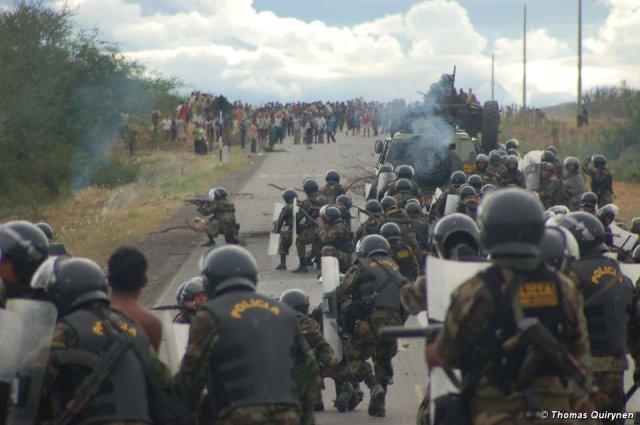
WikiLeaks cables released on June 9 shed new light on the United States' role in the Bagua Massacre in Peru on June 5, 2009.
The cables suggest then-US ambassador Michael McKinley may have encouraged the Peruvian government to use force against protesters in an operation that cost 10 protesters and 24 police officers their lives.
Indigenous groups in the Amazon had been blockading highways for seven weeks. They were protesting against decrees passed by Peru’s then-president Alan Garcia.
The decrees were passed to fulfil the terms of the US-Peru free trade agreement (FTA). Garcia made use of sweeping executive powers to pass 101 decrees in three months.
In the embassy cable sent on June 1, four days before the massacre, McKinley criticised “the government’s reluctance to use force to clear roads and blockades”. He said it was “contributing to the impression that the communities have broader support than they actually do”.
The Lima-based ambassador wrote: “Should Congress and President Garcia give in to the pressure, there would be implications for the recently implemented Peru-US FTA.”
The FTA granted greater rights to US investors. These included Colorado-based Newmont Mining, which had billions of dollars of interests in the area affected by protests.
Newmont, the world’s second-largest gold-mining company, holds a majority stake in Yanacocha, one of the world’s largest gold mines. Newmont is now developing the Conga mine, the biggest ever foreign investment in Peru.
Another cable, sent on June 5, provides an account of the outbreak of violence. Police sources cited by the ambassador said about 600 police moved on the blockade outside Bagua involving thousands of protesters.
Police started firing after a group of about 60 of their own became isolated and surrounded by the Amazonian protesters. Police sources claim that protesters triggered the violence by firing on a helicopter that was shooting tear gas into the crowd in support of the isolated police.
The police shot dead 10 protesters. Human rights groups later reported six indigenous men as missing, presumed dead.
Amazonian indigenous leader Alberto Pizango initially claimed that his people were unarmed and threatened with genocide. Yet 24 police officers were killed at Bagua, suggesting indigenous protesters fought back against police once the bloodshed began.
In total, 200 people were injured, including 82 who suffered bullet wounds. The events of June 5 did not end there, however.
Indigenous protesters had seized a nearby oil pipeline substation several days earlier as part of actions across the Peruvian Amazon. About 300 Awajun and Wampis men captured the station and held 38 police hostage.
When word arrived that their comrades had been shot at the highway blockade, the Amazonians killed 10 police in revenge.
In the face of the protest and outcry over the bloodshed, many of the contentious executive decrees that sparked the protests were revoked in the following weeks.
Northern Peruvian Amazonians are among the world’s most populous indigenous nations. Due to constant border conflict with Ecuador in the 20th century, Peru agreed to respect the independence of these nations in exchange for their support in any war against Ecuador.
For this reason, Garcia’s 2008 decrees were viewed as a betrayal of trust. Awajun, Wampis and Shuar indigenous peoples fought for Peru against Ecuador in 1981 and 1995.
The cables grant us an insight into how the world looks through the twisted lens of a US government official, with shades of the devastating “good intentions” that drove a US official to back war crimes in Vietnam in Graham Greene's The Quiet American.
A striking feature of the cables is the uncritical approach to information sourced from Peruvian police or government officials. McKinley said: “At the root of this crisis are social movement leaders seeking to make political hay by manipulating underlying grievances … to attack laws actually meant to promote economic development while maintaining indigenous peoples' constitutional rights.”
The ambassador’s interpretation of the US-Peru trade deal as some sort of benevolent aid program is incredibly naive.
The Peruvian parliament ultimately overturned 15 of the presidential decrees passed under the deal on the grounds they were unconstitutional and in violation of Peru’s obligations under the International Labor Organization's Convention No. 169 on indigenous rights. The Amazonian protest movement was only contesting 11 of the presidential decrees.
The legacy of the US development model championed by Kinsley is plain to see.
Since the Bagua massacre, the United Nations Special Rapporteur for Indigenous Peoples has reported “devastating consequences” from pollution caused by oil companies in the northern Peruvian Amazon. US oil giant ConocoPhillips holds 5.5 million acres of oil concessions in the area.
In denouncing the oil operations, Amazon Watch noted: “The Peruvian health ministry registered unacceptable levels of lead and cadmium in the blood of Achuar [indigenous] children.”
In Cajamarca, the province that hosts Newmont’s multi-billion-dollar gold mines, the population was placed under martial law for two months in 2012 following widespread blockades and protests against the contamination of the water table caused by the mines.
The US is not ungrateful for these services. It continues to give US$30 million annually in aid to Peru’s police and military, along with another $20 million in arms sales.
In 2010, just one year after the massacre, in a cable to the Pentagon’s Southern Command, the US Embassy praised Peru as “a trustworthy associate of the United States and a country that plays a constructive role in South America”.